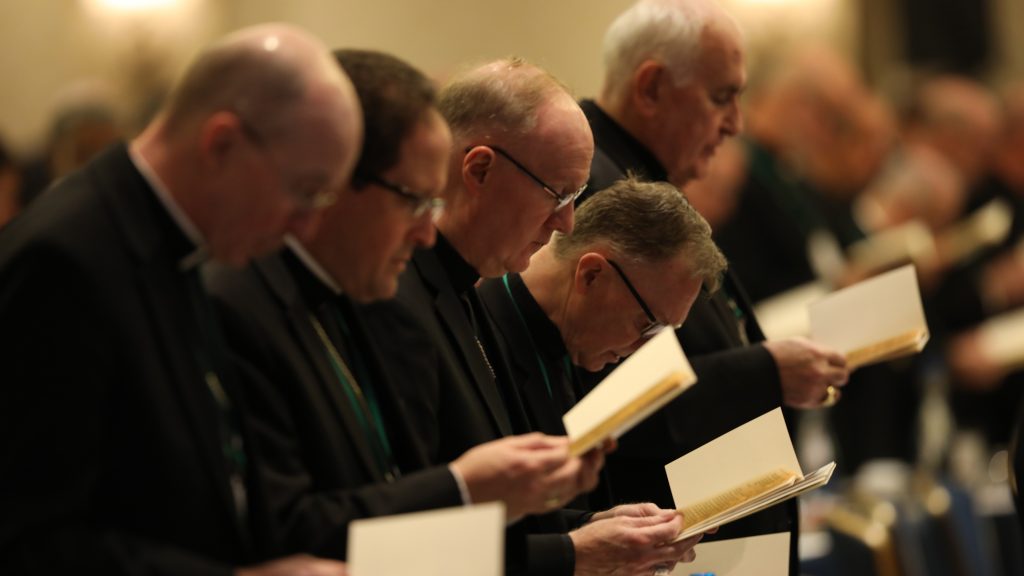The U.S. bishops’ conference fall meeting is unlikely to offer any surprises to Church observers watching to assembly. In fact, while the meeting begins today, its only real surprise came weeks ago, when the list of candidates for the conference presidency and vice presidency was published.
The bishops will elect a new president Tuesday, almost certain to be Archbishop José H. Gomez of Los Angeles, the conference vice president. The uncertain question is who they’ll elect as vice president, but Archbishop Paul Coakley of Oklahoma City and Archbishop Timothy Broglio of the military archdiocese are largely considered the front-runners, and one of them is likely to win.
But the surprise of the candidates’ list, released Oct. 21, is that nearly all the bishops eligible to be elected president or vice president are typically classified, at least by secular media, as “conservative.”
Ordinarily, candidates represent a cross-section of the theological and socio-political perspectives within the conference. But this year, each of the candidates, save for one, has been described as a “conservative,” and, to some extent, the label fits.
The categories of political sociology are not helpful in a Church context, because the modes of thinking and acting in the Church are very different from those of political partisanship.
Rather than speaking of “conservatives” and “liberals,” it is more accurate to say that the candidates for high office in the bishops’ conference can all be seen to represent the Communio school of post-Vatican II theological formation, instead of the Concilium school represented by Cardinal Blase Cupich and Bishop Robert McElroy.
The possible exception to this categorization of candidates is Bishop Dan Flores of Brownsville, who, as a rather well-read Thomist, does not fit neatly into either category. But in the contemporary theological landscape, a Thomist like Flores is generally thought to have common cause mostly with the Communio crowd. To borrow other, different, political language, Flores might be spoken of as an “independent” who usually caucuses with the Communio school.
In short, though, the nominees are more uniform in theological perspective than is typical for slates of conference candidates.
Candidates are selected by nomination; each bishop is asked during the summer months of an election year to nominate candidates for office, and those who get the most nominations in the running. The nominees they selected could be taken as a sign that most bishops hold to the Communio theological approach that defined the papacies of the St. John Paul II and Benedict XVI, rather than the Concilium approach, which has enjoyed a resurgence in some quarters during the pontificate of Pope Francis.
It could also mean that any of the Concilium bishops who got a nomination declined it. There are, indeed, rumors that at least one archbishop who fits Concilium mold turned down the nod. But the idea that the U.S. bishops are mostly cut from the mold of John Paul II and Benedict XVI, and tend to think like those men, is hardly radical, and it makes sense they would mostly nominate bishops of a similar vein.
But the nominees’ slate does signify that a one-time tradition in conference elections is probably over, for good. It has long been customary that the conference elect its vice president as president, and it was once customary that the top job alternated between “conservative” and “progressive”” bishops.
Both customs were interrupted in 2010. In that year, Cardinal Timothy Dolan, who was then considered to be a “conservative,” was elected president in a coup that saw “progressive” vice president, Bishop Gerald Kicanas, left out in the cold. Since Dolan’s election, two more mostly-conservative, Communio school bishops have been elected president of the conference.
Gomez, though naturally a bridge-builder and a man of modest temperament, falls rather squarely in the Communio school, and his successor is sure to as well. That will make five bishops of mostly similar theological orientation elected to lead the conference in a row. The unspoken custom of alternating between theological viewpoints seems to be dead.
Still, if the nomination of very similar bishops as candidates for the 2019 election signifies that the John Paul II Communio approach is the predominant viewpoint maong the U.S. bishops, it’s not certain how long that will last.
There are two Americans on the Vatican’s Congregation for Bishops, which plays a heavy role in nominating candidates to the episcopacy. One is Cardinal Donald Wuerl, who is 78 and will depart from the congregation in two years. Wuerl, leaving aside the personal disgrace in which he now finds himself, is regarding theologically as a moderate Communio bishop. The other is Cardinal Blase Cupich, who, with his language of “paradigm shifts,” is regarded most definitively as a Concilium figure.
If Cupich plays a principal role in the nomination of U.S. bishops, the American episcopacy will likely tend toward the Concilium school, even as the Communio crowd takes leadership posts at the conference. Once the Concilium bishops occupy 51% of the American episcopate, however, the tides will turn.
That future likelihood, in fact, may well be the reason why no Concilium bishops are running to be conference president. If they expect that the composition of the conference might undergo significant change in the next decade, they might judge it better simply to bide their time.
The real difference of opinion between Communio and Concilium bishops concerns the interpretive lens through which the documents of the Second Vatican Council, and indeed the Magisterium of the Church more broadly, should be read. That theological debate will have implications for decades, and perhaps centuries. For a sense of how the debate is going, the leadership and composition of the U.S. bishops' conference may prove to be a pretty good litmus test.
